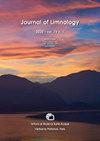墨西哥下加利福尼亚州特有的圣佩德罗马蒂尔鳟鱼(Oncorhynchus mykiss nelsoni)栖息的溪流温度的每日、季节和年度变化,以及2025年和2050年的预测温度
IF 1.1
4区 环境科学与生态学
Q4 LIMNOLOGY
引用次数: 1
摘要
本研究测量了1996年至2019年间,墨西哥下加利福尼亚州圣佩德罗马尔蒂尔山脉西坡分布的地方性虹鳟(Oncorhynchus mykiss nelsoni)溪流水温的每日、季节和年度变化。在不同海拔(553、1220和2080 m asl,或海拔米)的溪流中,确定了该鳟鱼亚种夏季温度高于温度阈值(≥28°C)的季节性热间隔和日持续时间。在2014年6月至9月的365小时内,海拔最低的溪流(San Antonio de Murillos Creek)的研究地点的温度记录为28°C,最高温度为30.66°C,是最容易受到全球变暖影响的地点。在San Antonio de Murillos Creek现场,三个模型(GFDL R30、HadCM3和Mote)预测的2025年平均水温将是一个非致命温度,<28°C,鳟鱼的最低海拔为491-511 masl,而2050年的平均水温预计为545-701 masl。预测的每小时28°C(非致命)的水温可能出现在2025年868-898 masl的最低海拔和2050年908-1028 masl的最小海拔,分别减少了其当前海拔分布范围的21-23%和23-31%,从而避免了其出现在典型地区(San Antonio de Murillos)。通讯作者:gruiz@uabc.edu.mx本文章由计算机程序翻译,如有差异,请以英文原文为准。
Daily, seasonal, and annual variability of temperature in streams inhabited by the endemic San Pedro Martir trout (Oncorhynchus mykiss nelsoni), in Baja California, Mexico, and the predicted temperature for the years 2025 and 2050
The present study measured the daily, seasonal, and annual variability of the water temperature of streams in which the endemic rainbow trout, Oncorhynchus mykiss nelsoni, is distributed on the western slope of the Sierra San Pedro Mártir, Baja California, Mexico, between 1996 and 2019. The seasonal thermal interval and daily duration of summer temperatures above the thermal threshold for this trout subspecies (≥28°C) were determined in streams at different elevations (553, 1,220, and 2,080 m asl, or meters above sea level). Temperatures 28°C were recorded at the study site on the stream with the lowest elevation (San Antonio de Murillos Creek) over an accumulated 365 h between June and September 2014, with the maximum temperature recorded there, 30.66 °C, making it the site most vulnerable to global warming. At the San Antonio de Murillos Creek site, the average water temperature predicted by three models (GFDL R30, HadCM3, and Mote) for the year 2025 would be a non-lethal temperature, <28°C, for trout at a minimum elevation of 491-511 masl, while this was predicted to be 545-701 masl for the year 2050. Predicted hourly water temperatures of 28°C (non-lethal) may occur at minimum elevations of 868-898 masl in 2025 and at 908-1028 masl in 2050, reducing a 21-23% and 23-31% its current altitudinal distribution range, respectively, thus avoiding its presence at the type locality (San Antonio de Murillos). Corresponding author: gruiz@uabc.edu.mx
求助全文
通过发布文献求助,成功后即可免费获取论文全文。
去求助
来源期刊

Journal of Limnology
地学-湖沼学
CiteScore
2.70
自引率
6.20%
发文量
12
审稿时长
3 months
期刊介绍:
The Journal of Limnology publishes peer-reviewed original papers, review papers and notes about all aspects of limnology. The scope of the Journal of Limnology comprises the ecology, biology, microbiology, physics, and chemistry of freshwaters, including the impact of human activities, management and conservation. Coverage includes molecular-, organism-, community-, and ecosystem-level studies on both applied and theoretical issues. Proceedings of workshops, specialized symposia, conferences, may also be accepted for publication.
 求助内容:
求助内容: 应助结果提醒方式:
应助结果提醒方式:


